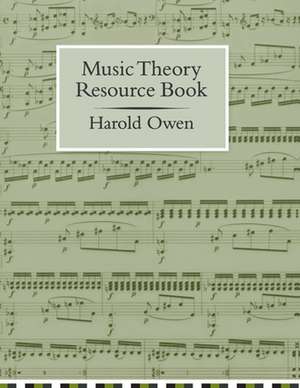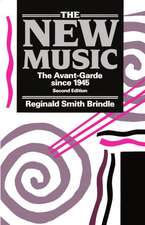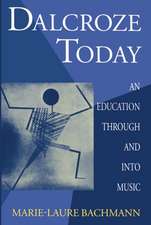Music Theory Resource Book
Autor Harold Owenen Limba Engleză Paperback – 14 mar 2001
Music Theory Resource Book covers topics not usually found in standard theory texts including basic acoustics, contrapuntal techniques, jazz harmony, musics from non-Western cultures, and music since 1950. The musical examples represent a wide variety of periods and genres and include such pieces as a mass movement by Josquin des Prez, a Russian folk tune, a lead sheet for a popular song, a choral piece by William Billings, an Indian raga, variations by Beethoven and Brahms, a chromatic motet by Lassus, and an organ work from the 1980s by Messiaen. Bach, Schumann, Chopin, Mozart, Franck, Debussy, Bartok, Hindemith, Dallapiccola, Stravinsky, Crumb, and P: art are also represented, and other examples have been composed especially for this book. Several detailed appendices include profiles summarizing the stylistic traits and compositional techniques of the Medieval, Renaissance, Baroque, Classical, and Romantic periods. Another appendix features a guide to figured bass realization, and a comprehensive glossary of terms provides a reference resource for students.
"
Preț: 831.86 lei
Preț vechi: 1139.53 lei
-27% Nou
Puncte Express: 1248
Preț estimativ în valută:
159.18€ • 173.60$ • 134.22£
159.18€ • 173.60$ • 134.22£
Carte disponibilă
Livrare economică 03-17 aprilie
Preluare comenzi: 021 569.72.76
Specificații
ISBN-13: 9780195115390
ISBN-10: 0195115392
Pagini: 272
Ilustrații: numerous music examples
Dimensiuni: 226 x 279 x 18 mm
Greutate: 0.65 kg
Editura: Oxford University Press
Colecția OUP USA
Locul publicării:New York, United States
ISBN-10: 0195115392
Pagini: 272
Ilustrații: numerous music examples
Dimensiuni: 226 x 279 x 18 mm
Greutate: 0.65 kg
Editura: Oxford University Press
Colecția OUP USA
Locul publicării:New York, United States
Descriere
Ideal as a core or supplementary text for the standard two-year music theory course and for graduate courses in theory review, Music Theory Resource Book covers all the topics typically studied in the basic music theory sequence. Concise and accessible, it features a basic anthology of musical examples—most of them complete compositions—from a broad range of periods and styles. Each chapter begins with these musical examples, which are followed bythought-provoking discussion questions that encourage students to learn through a "discovery" approach. A succinct outline follows the discussion questions, summarizing the principles of music theory for easy reference and review. Exercises at the end of each chapter engage students in a variety of analytical andpractical tasks ranging in difficulty from simple (designed for all students) to more challenging (intended for students with more extensive backgrounds). Music Theory Resource Book covers topics not usually found in standard theory texts including basic acoustics, contrapuntal techniques, jazz harmony, musics from non-Western cultures, and music since 1950. The musical examples represent a wide variety of periods and genres and include such pieces as a mass movement by Josquin des Prez, a Russian folk tune, a lead sheet for a popular song, a choral piece by William Billings, an Indian raga, variations by Beethoven and Brahms, achromatic motet by Lassus, and an organ work from the 1980s by Messiaen. Bach, Schumann, Chopin, Mozart, Franck, Debussy, Bartók Hindemith, Dallapiccola, Stravinsky, Crumb, and P:art are also represented, and other examples have been composed especially for this book. Several detailed appendices include profilessummarizing the stylistic traits and compositional techniques of the Medieval, Renaissance, Baroque, Classical, and Romantic periods. Another appendix features a guide to figured bass realization, and a comprehensive glossary of terms provides a reference resource for students.










